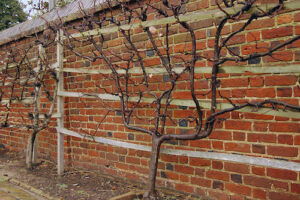Fancy Forms: Pleached, Espaliers and Standards
by Janet Scheren, Fairfax Master Gardener
Pleached, espaliers, and standards are not just fancy names for shapes of trees that have been trained. Each represents a specific approach or technique that fulfills a purpose, use of space/location or training technique.
Espaliers — While you can espalier any tree, this technique is most used with fruit trees. The espalier technique dates to the Romans but was refined in the 1500s in France. It has several advantages: Limbs trained horizontally produce more fruit than upward reaching branches. These trees also take less space and can be grafted with multiple cultivars, making them perfect for small or narrow gardens. It’s also easier to harvest fruit on espaliered trees as well as spot and manage pests. Additionally, espaliers typically provide added protection from winter frost damage, and their fruit ripens more quickly because it’s typically grown against a solid, south-facing wall. Finally, espaliered trees enhance the garden design, and they can also hide or add dimension to a wall or fence.
Spur bearing fruit trees, such as apples, pears, quinces, apricots, cherries, plums and citrus, are good candidates for espaliers. Figs, nectarines/peaches, persimmons and pomegranates are more challenging because these fruits are grown at the ends of long branches. Whatever type of fruit tree you choose, it is best to purchase a plant with dwarf or semi-dwarf root stock. This will help to slow the annual growth of the plant, without compromising fruit production. Non fruiting trees that are often trained as espaliers include roses, jasmines and camellias.
A downside of espaliers is that they take several years to establish because you can typically only grow one layer per year. Another downside is that some fruits, such as Asian pears, may get some sun damage. It also takes a bit of planning. Start by attaching your support sires to your walls. Then you train that year’s growth to the first layer. In subsequent years you can add another layer.

Espalier at Mt. Vernon

Espaliered pears
Tree standards — Think of a tree standard as a three-dimensional hedge on stilts. Any tree with a single bare trunk devoid of leaves or branches and topped with foliage is called a standard. More frequently, however, what we think of as a standard is a woody shrub with a single trunk shaped into a tree-like form. Among the plants suitable for standard training are gardenias, roses, fuchsias, hydrangeas, rosemary, oleanders, camelias, laurels, boxwoods and weeping figs. Depending on the plant’s height, the trunk will be bare somewhere between 3 to 6 feet from the ground. Standards provide a decorative element in your landscape. They are often grown in pots and make excellent accent plants on a deck, patio or porch. You can also grow them in a narrow space against a wall. Here the trunk extends to the top of the wall with the foliage fully above the wall. If you have a narrow space, you need to train or buy them with stems tall enough to clear the wall height. Tree standards used in this sense can provide screening and privacy above a wall without taking up a lot of space in the garden.

Tree standards in planters
Pleached trees — Think of pleached trees as a flat hedge on stilts. Pleached trees add an architectural element to a garden. They are trained on a framework, which can be free standing or attached to a fence. Here the branches are actually woven into tiers or solid masses and twisted along the framework to form a tall, flat screen. This framework is often taller than the fence. This provides another option to achieve privacy and leafiness above a fence line. They work well in narrow, more formal gardens.
To pleach a tree you tie and interlace flexible young shoots along a supporting framework. This technique can also be used to create walls, arbors, tunnels or arches. Laburnum and wisteria are often used for pleached arbors or tunnels to show off their beautiful and fragrant flowers. Other suitable trees are beach, hornbeams, lime trees and ornamental pears.
For pleaching, always start with young, whippy plants. You’ll want to plant and prune pleached trees in the winter when they are leafless and dormant. You’ll train and tie new shoots in the summer as the plants grow. Trees/plants for pleaching should be space about 4 feet apart in a straight row. For an allée, place parallel rows 8 to 10 feet apart.
As the structure grows, prune back outward growing shoots. When the branch system has been formed and no additional growth is needed, begin pinching out leading growth to encourage bushiness and retain its shape. Once the structure is fully grown and stable, the supports can be removed.

Hall Place pleached trees

Linderhof Palace Arbor
Resources
Espalier, UC Master Gardeners of Napa County weekly column, December 8, 2015
Wave of the Future: Espalier for Production and Pest Management, Napa Master Gardener Meeting,
May 28, 2015
Pleached walks, tunnels and arbours, Royal Horticulture Society